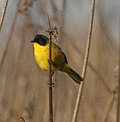Superregnum: Eukaryota
Regnum: Animalia
Subregnum: Eumetazoa
Cladus: Bilateria
Cladus: Nephrozoa
Superphylum: Deuterostomia
Phylum: Chordata
Cladus: Craniata
Subphylum: Vertebrata
Infraphylum: Gnathostomata
Superclassis: Tetrapoda
Cladus: Reptiliomorpha
Cladus: Amniota
Classis: Reptilia
Cladus: Eureptilia
Cladus: Romeriida
Subclassis: Diapsida
Cladus: Sauria
Infraclassis: Archosauromorpha
Cladus: Crurotarsi
Divisio: Archosauria
Subsectio: Ornithodira
Subtaxon: Dinosauromorpha
Cladus: Dinosauria
Ordo: Saurischia
Cladus: Theropoda
Cladus: Neotheropoda
Infraclassis: Aves
Ordo: Passeriformes
Subordo: Passeri
Infraordo: Passerida
Superfamilia: Passeroidea
Familia: Parulidae
Genus: Geothlypis
Species: G. aequinoctialis – G. auricularis – G. beldingi – G. chiriquensis – G. flavovelata – G. formosa – G. nelsoni – G. philadelphia – G. poliocephala – G. rostrata – G. semiflava – G. speciosa – G. tolmiei – G. trichas – G. velata
G. aequinoctialis - -
Name
Geothlypis Cabanis, 1847
Typus: Turdus trichas Linnaeus, 1766 = Geothlypis trichas
Synonyms
Chamaethlypis Ridgway, 1887 Man.N.Am.Birds p. 525 BHL
References
Primary references
Cabanis J. 1847. Ornithologische Notizen I p.186–256, II p.308–352. In: Archive fur Naturgeschichte, Year 13, Vol 1, 352 pp. Nicolai'schen Buchhandlung - Berlin. First availability p. 316 BHL Reference page. p. 349 BHL
Additional references
Lovette, I.J., Pérez-Emán, J.L., Sullivan, J.P., Banks, R.C., Fiorentino, I., Córdoba-Córdoba, S., Echeverry-Galvis, M., Barker, F.K., Burns, K.J., Klicka, J., Lanyon, S.M. & Berminghan, E. 2010. A comprehensive multilocus phylogeny for the wood-warblers and a revised classification of the Parulidae (Aves). Molecular phylogenetics and evolution 57 (2): 753–770. DOI: 10.1016/j.ympev.2010.07.018 Full article (PDF)Reference page.
Vernacular names
English: Yellowthroat
suomi: Naamiokerttulit
The yellowthroats are New World warblers in the genus Geothlypis. Most members of the group have localised ranges in Mexico and Central America, but the masked yellowthroat has an extensive South American distribution, while the common yellowthroat breeds over much of North America.
All the yellowthroats have similar plumage, with yellow-green upperparts, yellow breast, and a mainly black bill. The adult male has a black facemask of variable extent, usually bordered above with a grey band. The female is similar, but lacks the black mask, and may be duller in plumage.
The breeding habitat of these warblers is typically marshes and other wet areas with dense low vegetation. The eggs, two in most species, but up to five for common yellowthroat, are laid in a lined cup nest low in grass or rank vegetation.
Yellowthroat are usually seen in pairs, and do not associate with other species. They are often skulking, and feed on a range of insects.
The taxonomy of these closely related species is complicated, and it is sometimes difficult to define which forms merit species status. For example common yellowthroat, Belding's yellowthroat, Altamira yellowthroat, and Bahama yellowthroat are sometimes considered conspecific. Conversely masked yellowthroat can be split to three or even four species. The name 'yellowthroat' is sometimes used as an alternate name for the yellow-throated leaflove.[1]
The geographical isolation of the various populations of this mainly sedentary group has led to its genetic divergence and speciation. This process can be seen in action in the case of masked yellowthroat, where the subspecies are separated by rainforest or the Andes, leading to the development of distinctive forms, such as the Central American race Geothlypis aequinoctialis chiriquensis. This form is found in the highlands of Costa Rica and western Panama, and is separated by 1000 km from its South American cousins, from which it differs in size, appearance and vocalisations.
The Kentucky warbler, mourning warbler, and MacGillivray's warbler, all previously thought to have been members of the genus Oporornis, have since been moved to Geothlypis.[2]
Species
| Image | Scientific name | Common Name | Distribution |
|---|---|---|---|
 |
Geothlypis trichas | Common yellowthroat | southern Canada to central Mexico. |
 |
Geothlypis beldingi | Belding's yellowthroat | southern Baja California, Mexico. |
 |
Geothlypis flavovelata | Altamira yellowthroat | Gulf slope of northeastern Mexico |
 |
Geothlypis rostrata | Bahama yellowthroat | the Bahamas. |
 |
Geothlypis semiflava | Olive-crowned yellowthroat | Colombia, Costa Rica, Ecuador, Honduras, Mexico, Nicaragua, and Panama. |
 |
Geothlypis speciosa | Black-polled yellowthroat | central Mexico and the southwestern Mexican Plateau, in Guanajuato, Michoacán, and México State. |
 |
Geothlypis aequinoctialis | Masked yellowthroat | Central and South America |
 Costa Rica (26652422686).jpg" decoding="async" srcset="//upload.wikimedia.org/wikipedia/commons/thumb/4/40/Grey-crowned_Yellowthroat_-_Sarapiqui_-_Costa_Rica_%2826652422686%29.jpg/180px-Grey-crowned_Yellowthroat_-_Sarapiqui_-_Costa_Rica_%2826652422686%29.jpg 1.5x, //upload.wikimedia.org/wikipedia/commons/thumb/4/40/Grey-crowned_Yellowthroat_-_Sarapiqui_-_Costa_Rica_%2826652422686%29.jpg/240px-Grey-crowned_Yellowthroat_-_Sarapiqui_-_Costa_Rica_%2826652422686%29.jpg 2x" data-file-width="1140" data-file-height="760" height="80" width="120" /> Costa Rica (26652422686).jpg" decoding="async" srcset="//upload.wikimedia.org/wikipedia/commons/thumb/4/40/Grey-crowned_Yellowthroat_-_Sarapiqui_-_Costa_Rica_%2826652422686%29.jpg/180px-Grey-crowned_Yellowthroat_-_Sarapiqui_-_Costa_Rica_%2826652422686%29.jpg 1.5x, //upload.wikimedia.org/wikipedia/commons/thumb/4/40/Grey-crowned_Yellowthroat_-_Sarapiqui_-_Costa_Rica_%2826652422686%29.jpg/240px-Grey-crowned_Yellowthroat_-_Sarapiqui_-_Costa_Rica_%2826652422686%29.jpg 2x" data-file-width="1140" data-file-height="760" height="80" width="120" /> |
Geothlypis poliocephala | Gray-crowned yellowthroat | Belize, Costa Rica, El Salvador, Guatemala, Honduras, Mexico, Nicaragua, Panama, and the United States. |
| Geothlypis nelsoni | Hooded yellowthroat | Mexico north of the Isthmus of Tehuantepec. | |
 |
Geothlypis tolmiei | MacGillivray's warbler | western United States, and in boreal forests of west Canada. |
 |
Geothlypis philadelphia | Mourning warbler | southern Canada, the central and eastern United States, Belieze, Bonaire, Puerto Rico, Guatemala, Panama, and other Central American Islands |
 |
Geothlypis formosa | Kentucky warbler | central and eastern United States, often ranging as far north as Wisconsin to Pennsylvania. |
References
"Atimastillas flavicollis - Avibase". avibase.bsc-eoc.org. Retrieved 2017-04-17.
Lovette, Irby; Pérez-Emán, Jorge; Sullivan, John; Banks, Richard; Fiorentino, Isabella; Córdoba-Córdoba, Sergio; Echeverry-Galvis, María; Barker, F.; Burns, Kevin; Klicka, John; Lanyon, Scott; Bermingham, Eldredge (7 August 2010). "A comprehensive multilocus phylogeny for the wood-warblers and a revised classification of the Parulidae (Aves)". Molecular Phylogenetics and Evolution. 57: 753–770. doi:10.1016/j.ympev.2010.07.018. Retrieved 30 June 2020.
Curson, Quinn and Beadle, New World Warblers ISBN 0-7136-3932-6
ffrench, Richard (1991). A Guide to the Birds of Trinidad and Tobago (2nd ed.). Comstock Publishing. ISBN 0-8014-9792-2.
Hilty, Birds of Venezuela ISBN 0-7136-6418-5
Stiles and Skutch, A guide to the birds of Costa Rica ISBN 0-8014-9600-4
Retrieved from "http://en.wikipedia.org/"
All text is available under the terms of the GNU Free Documentation License

